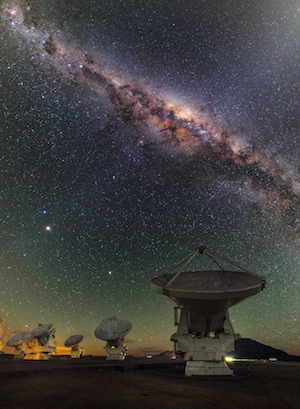A natural satellite or moon is, in the most common usage, an astronomical body that orbits a planet or minor planet (or sometimes another small Solar System body).
In the Solar System there are six planetary satellite systems containing 185 known natural satellites.[1][2] Four IAU-listed dwarf planets are also known to have natural satellites: Pluto, Haumea, Makemake, and Eris.[3] As of September 2018, there are 334 other minor planets known to have moons.[4]
The Earth–Moon system is unique in that the ratio of the mass of the Moon to the mass of Earth is much greater than that of any other natural-satellite–planet ratio in the Solar System (although there are minor-planet systems with even greater ratios, notably the Pluto–Charon system). At 3,474 km (2,158 miles) across, the Moon is 0.27 times the diameter of Earth
The first known natural satellite was the Moon, but it was considered a "planet" until Copernicus' introduction of De revolutionibus orbium coelestium in 1543. Until the discovery of the Galilean satellites in 1610, however, there was no opportunity for referring to such objects as a class. Galileochose to refer to his discoveries as Planetæ("planets"), but later discoverers chose other terms to distinguish them from the objects they orbited.[citation needed]
The first to use of the term satellite to describe orbiting bodies was the German astronomer Johannes Kepler in his pamphlet Narratio de Observatis a se quatuor Iouis satellitibus erronibus ("Narration About Four Satellites of Jupiter Observed") in 1610. He derived the term from the Latin word satelles, meaning "guard", "attendant", or "companion", because the satellites accompanied their primary planet in their journey through the heavens.[6]
The term satellite thus became the normal one for referring to an object orbiting a planet, as it avoided the ambiguity of "moon". In 1957, however, the launching of the artificial object Sputnik created a need for new terminology. Sputnik was created by Soviet Union, and it was the first satellite ever.[6] The terms man-made satellite and artificial moon were very quickly abandoned in favor of the simpler satellite, and as a consequence, the term has become linked primarily with artificial objects flown in space – including, sometimes, even those not in orbit around a planet.[citation needed]
Because of this shift in meaning, the term moon, which had continued to be used in a generic sense in works of popular science and in fiction, has regained respectability and is now used interchangeably with natural satellite, even in scientific articles. When it is necessary to avoid both the ambiguity of confusion with Earth's natural satellite the Moon and the natural satellites of the other planets on the one hand, and artificial satellites on the other, the term natural satellite (using "natural" in a sense opposed to "artificial") is used. To further avoid ambiguity, the convention is to capitalize the word Moon when referring to Earth's natural satellite, but not when referring to other natural satellites.
Many authors define "satellite" or "natural satellite" as orbiting some planet or minor planet, synonymous with "moon" – by such a definition all natural satellites are moons, but Earth and other planets are not satellites.[7][8][9] A few recent authors define "moon" as "a satellite of a planet or minor planet", and "planet" as "a satellite of a star" – such authors consider Earth as a "natural satellite of the sun".
There is no established lower limit on what is considered a "moon". Every natural celestial body with an identified orbit around a planet of the Solar System, some as small as a kilometer across, has been considered a moon, though objects a tenth that size within Saturn's rings, which have not been directly observed, have been called moonlets. Small asteroid moons (natural satellites of asteroids), such as Dactyl, have also been called moonlets.






